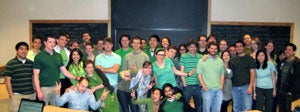After a yearlong competition involving sustainability pledges, bottled water and green apparel, Section 6 emerged victorious in the first-annual Harvard Law School 1L Green Cup.
Led by volunteer section green reps, the seven 1L sections competed against each other in five participation-based challenges designed to raise awareness about environmentally friendly behaviors that positively impact campus sustainability.
The competition began in October with the University-wide Sustainability Pledge in which students committed to taking everyday actions to reduce their environmental impact. Nearly half of all 1Ls took part in this challenge, and Section 6 took an early lead with 100 percent participation.
In November, students participated in a water taste test in which they sampled three types of water—Cambridge tap, filtered tap and Poland Springs—and attempted to identify which was the bottled water.
The Green Cup competition picked up with two events in February: a “Fashion Swapaganza” and “Choose to Reuse.” The Women’s Law Association co-sponsored a clothing swap that encouraged the conservation of resources by trading and re-using clothing instead of buying new. As part of the “Choose to Reuse” initiative, students brought a re-useable water bottle, coffee mug or food container to class to reduce waste created by disposable containers.
With an overall participation rate of 61 percent in the challenges, Section 6 took home the title of Green Cup champions—and, according to Section 6 Green Rep Victor Ban, a greater appreciation for how to make incremental changes in their daily lives to reduce their carbon footprint.
“The green section competition is so important because it shows how powerful seemingly small choices can be,” Ban said. “Whether it’s buying a bottle of water or discarding something we’re no longer using, the choices we make in daily life can impact both our environment and the attitudes of others in our community, who in turn make their own choices with environmental consequences. The competition does a great job of demonstrating this double impact.”
Beyond the goal of educating new students about ways to contribute to campus sustainability, Ban said that the competition also inspired greater cohesion among 1L students.
“Beyond our section, the competition created a larger 1L community that doesn’t often come together given that each section is on its own class schedule,” he said. “I came to know several other section green reps as we worked together to manage events. They’re an inspiring and extremely knowledgeable group, and they brought a lot of creativity to planning the competition in its inaugural year. The competition also became a fun topic of conversation among 1Ls and was a great way for people to connect across sections.”
